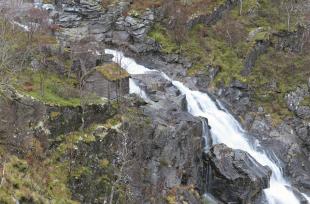But many years were to pass before the plans got off the ground. True, a road was built from Matre to Hummelfossen in 1915, and houses for administrative personnel had been built in Matre. But during WW1 Europe entered a turbulent time, and the plans for power development in Matre were put on hold. In 1917 the work was re-started, with Norsk Hydro as developer. The power station and the pipe trench were finished in 1919, but the station was not put into operation. It was the German occupying power that was in charge of the work. After the war Bergenshalvøens Kommunale Kraftselskap (BKK) took over the facility. The station from 1919 was pulled down. The power station buildings standing today are from 1953; one of the many small facilities that have supplied power to the local community. In 1986 a new modern station was built, and the power station from 1953 now became a museum.
Hummelfossen power station.. (Svein Nord)
Hummelfossen
As early as 1906 the Matre and Haugsdal waterway was bought up by the businessman Blauuw from Bergen; the first “waterfall speculator” in the Matre area. He immediately resold it to Fr. Hiorth, who transferred all the rights to the company Matrefaldene in 1908. Behind A/S Matrefaldene were German interests, Badische Anilin und Sodafabrik, which wanted to start production of saltpetre fertilizer with nitrogen and electricity.


